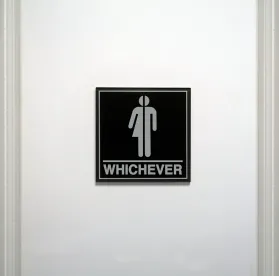On June 15, 2020, the Supreme Court of the United States issued its decision in Bostock v. Clayton County, Georgia, holding that, pursuant to Title VII of the Civil Rights Act of 1964, covered employers may not discriminate against applicants or employees on the basis of sexual orientation or gender identity.
Near the end of the 33-page majority opinion, Justice Gorsuch turned to the “consequences” of such a holding:
What are these consequences anyway? The employers worry that our decision will sweep beyond Title VII to other federal or state laws that prohibit sex discrimination. And, under Title VII itself, they say sex-segregated bathrooms, locker rooms, and dress codes will prove unsustainable after our decision today. But none of these other laws are before us; we have not had the benefit of adversarial testing about the meaning of their terms and we do not prejudge any such question today. Under Title VII, too, we do not purport to address bathrooms, locker rooms, or anything else of the kind. The only question before us is whether an employer who fires someone simply for being homosexual or transgender has discharged or otherwise discriminated against that individual “because of such individual’s sex.”… Firing employees because of a statutorily protected trait surely counts. Whether other policies and practices might or might not qualify as unlawful discrimination or find justifications under other provisions of Title VII are questions for future cases, not these.
Thus, Justice Gorsuch appeared to narrow the Court’s holding to discriminatory terminations of employment. Does the holding mean that employers have been left without guidance as to other practical implications and consequences of the decision? No. As a preliminary matter, it is important to keep in mind that Title VII does not apply to every employer in the United States. The term “employer” under Title VII means “a person engaged in an industry affecting commerce who has fifteen or more employees for each working day in each of twenty or more calendar weeks in the current or preceding calendar year, and any agent of such a person,” although the law provides certain exceptions. Many employees in the United States are employed by employers that have fewer than 15 employees and are thus not covered by Title VII.
Other federal, state, or local protections may come into play. For example, since July 2014, Executive Order 13672 has prohibited federal contractors and federally assisted construction contractors and subcontractors that do over $10,000 in government business in one year from discriminating on the basis of sexual orientation and gender identity. Further, at least 22 states prohibit discrimination on the basis of sexual orientation and gender identity in private employment, and hundreds of counties and municipalities prohibit discrimination on the basis of sexual orientation and/or gender identity in both public and private employment.
Although Bostock marked the first time the Supreme Court addressed the question of whether Title VII prohibited employment discrimination on the basis of sexual orientation and gender identity, lower courts and governmental agencies had long held that Title VII prohibited such discrimination. Accordingly, the Bostock holding, taken together with prior federal court rulings and agency interpretations, can provide helpful practical guidance for employers dealing with issues such as sex-segregated facilities usage.
The Equal Employment Opportunity Commission (EEOC) has taken the position since its 2012 decision in Macy v. Holder—a ruling later cited by the U.S. Department of Justice in a 2014 memo regarding the treatment of transgender employment discrimination claims—that Title VII’s prohibition on sex discrimination includes discrimination on the basis of gender identity. In addition, the EEOC has issued guidance for employers clarifying its position that employers must allow employees to use restrooms, locker rooms, and any other “sex-segregated” facilities consistent with the employees’ gender identities, regardless of sex assigned at birth. The EEOC, for example, directs employers to allow transgender females to use women’s restrooms, regardless of sex assigned at birth and regardless of any particular sex-reaffirmation procedures.
Similarly, in June 2015, the Occupational Safety and Health Administration (OSHA) issued a “Guide to Restroom Access for Transgender Workers,” which explained to employers that safe restroom access was within the agency’s purview and that transgender employees should be permitted to utilize restroom facilities consistent with their gender identities for their safety and health.
Notably, some states and localities already have “all-gender” or “gender-neutral” bathroom requirements when a single-user bathroom is at issue. For example, California’s Equal Restroom Access Act and related regulations require some establishments with single-occupancy restrooms to display signs indicating that the restroom is gender-neutral. Further, the restroom access provisions of California’s Code of Regulations require that employers allow employees to use restrooms that correspond with their gender identities or gender expression, regardless of sex assigned at birth.
In Vermont, under Act 127, all single-user bathrooms in public buildings or places of public accommodation are required to be labeled “restroom” or “bathroom” and made available for use by persons of any gender or by those who identify as neither gender. Illinois has a similar law, which requires that public buildings under new construction include gender-neutral single-occupancy restrooms.
A number of cities have also implemented single-user gender-neutral restroom laws, including, but not limited to, Austin; Berkeley, California; Chicago; Denver; Evanston, Illinois; New York City; Philadelphia; Portland, Oregon; Santa Fe, New Mexico; Seattle; Washington, D.C.; and West Hollywood, California. Similarly, local jurisdictions have been implementing specific directives concerning restroom usage for employees. Indeed, it has been illegal in New York City to discriminate against an individual on the basis of gender identity or expression, including denying access to bathrooms, since 2002.
In sum, although the Supreme Court’s Bostock decision leaves restroom-usage questions to be addressed another day, employers may want to remain cognizant of the multitude of existing laws and guidance in this arena. To remain compliant with the law—whether local, state, or federal—employers may want to consider converting single-user restroom to gender-neutral restrooms and permitting employees to use restrooms consistent with gender identity regardless of sex assigned at birth.
Part two of this three-part series will focus on dress codes in the wake of the Bostock decision.




 />i
/>i
